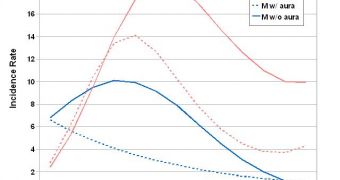Most of you know that when a headache or a migraine strikes, a shadowy corner, or a room with as little light as possible, is the natural choice. Apparently, less bright lights have an alleviating effect on the pain, and this has puzzled researchers for many years. Now, finally, experts have managed to discover why we tend to steer clear of bright lights when experiencing headaches, and also the mechanisms that underlie this “vulnerability,” LiveScience reports.
It would now seem that this sensitivity is triggered by a neural pathway in the human brain, which was discovered by a team of investigators from the Beth Israel Deaconess Medical Center, and the Harvard Medical School, in Boston, Massachusetts. Their research was conducted on two patient groups. People in both groups were suffering from migraines, but members of one were blind, whereas those in the other had a normal eyesight. In addition to humans, the research was also conducted on rats.
“Clinically, this research sets the stage for identifying ways to block the pathway so that migraine patients can endure light without pain,” BIDMC Professor of Anesthesia and Critical Care Medicine Rami Burstein explains. The team also reveals that the pathways were more specifically identified in the rat portion of the study. However, the experts steer clear of showing optimism about this research, for the simple reason that many discoveries made on mice do not translate to humans as well as the researchers behind them would want to.
It is currently estimated that about 85 percent of the 30 million migraine/headache patients in the United States are also suffering from photophobia, which means they can't stand light. What puzzled researchers was the fact that some blind patients seemed to be experiencing an upheaval in pain when exposed to bright lights as well. So, they hypothesized that, as optical impulses were passed from the retina to the brain, they somehow contributed to the intensification of the pain.
“The mechanism of photophobia must involve the optic nerve, because in totally blind individuals, the optic nerve does not carry light signals to the brain,” Burstein says. After dying the eyes of rats to track the path of a pigment known as melanopsin, the researchers discovered a group of neurons in the brain became electrically active when migraines ensued. “When small electrodes were inserted into these 'migraine neurons,' we discovered that light was triggering a flow of electrical signals that was converging on these very cells. This increased their activity within seconds,” the expert adds.
In a paper that appears in the January 10 online issue of the respected scientific journal Nature Neuroscience, the group adds that, “This helps explain why patients say that their headache intensifies within seconds after exposure to light, and improves 20 to 30 minutes after being in the dark.”

 14 DAY TRIAL //
14 DAY TRIAL //